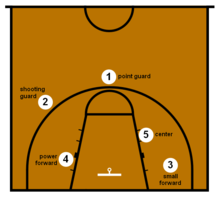Basketball positions
The three basketball positions normally employed by organized basketball teams are the guards, forwards, and the center. More specifically, they can be classified into the five positions: point guard(PG), shooting guard(SG), small forward(SF), power forward(PF), and center(C). The rules of basketball do not mandate them, and in informal games they are sometimes not used. They are grouped into two conceptual units: the offensive and defensive. Point guard Main article: Point guard The point guard, also known as the one, is typically the team's best ball handler and passer. He is often responsible for directing plays, making the position equivalent to that of play-making midfielder in association football, setter in volleyball, quarterback in American football, or center in ice hockey. Good point guards increase team efficiency and generally have a high number of assists. The point guard is typically the smallest player on his squad. At the NBA level, most point guards are 6 feet (1.83 m) to 6 feet 4 inches (1.93 m). In Europe, point guards' height ranges from 5 feet 11 inches (1.80 m) to 6 feet 4 inches (1.93 m), with a few exceptions. Notable exceptions include Earvin "Magic" Johnson, who was the NBA's tallest point guard ever to play the position, at 6 feet 9 inches (2.06 m). In comparison, the shortest players include Muggsy Bogues at 5 feet 3 inches (1.60 m) and Earl Boykins at 5 feet 5 inches (1.65 m). [edit]Shooting guard Main article: Shooting guard The shooting guard, also known as the two, is usually the team's best shooter, and typically is able, to consistently hit long range shots (of 20 feet or more). Besides being able to shoot the ball, shooting guards tend to have good ball-handling skills and the ability to drive the ball to the net, often creating their own shots off the dribble. A versatile shooting guard will have good passing skills, allowing them to assume point guard responsibilities. [edit] Frontcourt (forwards and center) [edit]Small forward Main article: Small forward The small forward (SF), colloquially known as the three, is typically somewhat shorter, quicker and leaner than power forwards and centers. Thus, in the NBA, small forwards range from 6 feet 6 inches (1.96 m) to 6 feet 9 inches (2.06 m). European small forward height ranges from 6 feet 4 inches (1.93 m) to 6 feet 8 inches (2.03 m). The small forward position is considered to be perhaps the most versatile of the main five basketball positions, due to the nature of its role, which is sometimes similar to that of a power forward, and other times more resembles the role of a shooting guard. The small forward and shooting guard positions are often interchangeable. Small forwards have a variety of assets, such as

uickness and strength inside. One common thread between all kinds of small forwards is an ability to "get to the line" and draw fouls by aggressively attempting post-up plays, lay-ups, or slam dunks. As such, accurate foul shooting is a common skill for small forwards, many of whom record a large portion of their points from the foul line. Small forwards should be able to do a little bit of everything on the court, typically playing roles such as swingmen but also as point forwards and defensive specialists. [edit]Power Forward Main article: Power forward (basketball) Also known as the "4" position the Power forward plays a role similar to that of the center, down in the "post" or "low blocks". On offense, they are the team's most valuable player for shooting, and can post up for mid-range jump shots. [edit]Center Main article: Center (basketball) The center, also referred to as the "5" or the "pivot", usually plays near the baseline, close to the basket (referred to as the "bottom of the key" or the "low post"). The center is usually a key player in the game of basketball. The tallest player is most likely to be assigned to the position of center, with typical NBA centers being about 7 feet (2.13 m) in height, though Chuck Hayes fills this role at 6 feet 6 inches (1.98 m), and NBA Hall of Fame Wes Unseld filled this role while being 6 feet 7 inches (2.01 m). European centers tend to be over 6 feet 10 inches (2.08 m) tall, but very few are taller than 7 feet 0 inches (2.13 m). The center usually scores "down low, in the paint" (near the basket, in the key), but some can be good perimeter shooters, which can draw a good rebounding and skill to score close to the basket, as well as gathering rebounds, contesting shots and setting screens on plays. This can also be called post in a less competitive area of play. The Center position has been traditionally considered as one of, if not, the most important positions. Players such as Hakeem Olajuwon, Patrick Ewing, Shaquille O'Neal, Yao Ming, Bill Russel and Dwight Howard were all chosen with first overall picks due to the rarity of "franchise centers." The scope of the position has transitioned from relatively slower but much taller 'back to the basket' players to players who would normally be classified as power forwards but can dominate the position with their athletic prowess, defensive skills, or mismatch ability to shoot from the high post. This has been due to the lack of players possessing the combination of great skill, ideal height, and durability. This has been matched by the development of more fast-paced and athletic basketball play; the 'Run and Gun' offenses of coaches call for less traditional center play and a more up-and-down the court style.